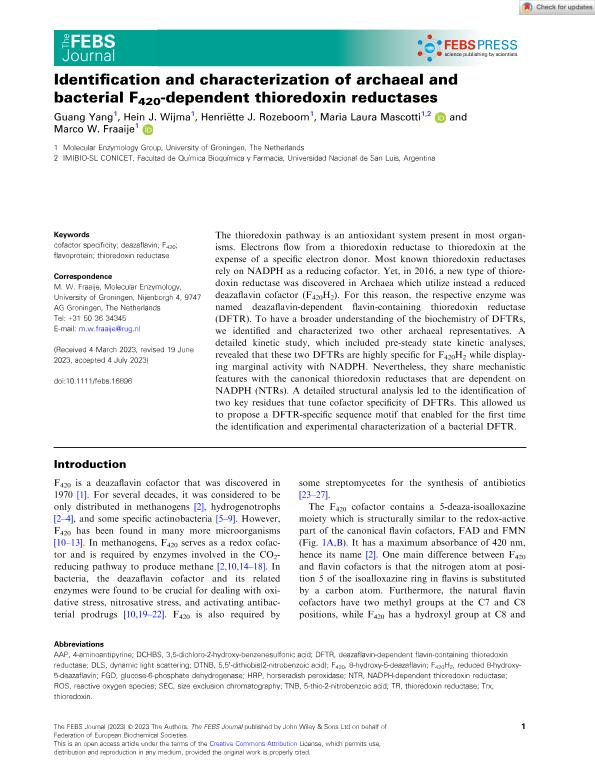Artículo
Identification and characterization of archaeal and bacterial F420-dependent thioredoxin reductases
Yang, Guang; Wijma, Hein J.; Rozeboom, Henriëtte J.; Mascotti, María Laura ; Fraaije, Marco Wilhelmus
; Fraaije, Marco Wilhelmus
 ; Fraaije, Marco Wilhelmus
; Fraaije, Marco Wilhelmus
Fecha de publicación:
07/2023
Editorial:
Wiley Blackwell Publishing, Inc
Revista:
Febs Journal
ISSN:
1742-464X
Idioma:
Inglés
Tipo de recurso:
Artículo publicado
Clasificación temática:
Resumen
The thioredoxin pathway is an antioxidant system present in most organisms. Electrons flow from a thioredoxin reductase to thioredoxin at the expense of a specific electron donor. Most known thioredoxin reductases rely on NADPH as a reducing cofactor. Yet, in 2016, a new type of thioredoxin reductase was discovered in Archaea which utilize instead a reduced deazaflavin cofactor (F420H2). For this reason, the respective enzyme was named deazaflavin-dependent flavin-containing thioredoxin reductase (DFTR). To have a broader understanding of the biochemistry of DFTRs, we identified and characterized two other archaeal representatives. A detailed kinetic study, which included pre-steady state kinetic analyses, revealed that these two DFTRs are highly specific for F420H2 while displaying marginal activity with NADPH. Nevertheless, they share mechanistic features with the canonical thioredoxin reductases that are dependent on NADPH (NTRs). A detailed structural analysis led to the identification of two key residues that tune cofactor specificity of DFTRs. This allowed us to propose a DFTR-specific sequence motif that enabled for the first time the identification and experimental characterization of a bacterial DFTR.
Palabras clave:
COFACTOR SPECIFICITY
,
DEAZAFLAVIN
,
F420
,
FLAVOPROTEIN
,
THIOREDOXIN REDUCTASE
Archivos asociados
Licencia
Identificadores
Colecciones
Articulos(IMIBIO-SL)
Articulos de INST. MULTIDICIPLINARIO DE INV. BIO. DE SAN LUIS
Articulos de INST. MULTIDICIPLINARIO DE INV. BIO. DE SAN LUIS
Citación
Yang, Guang; Wijma, Hein J.; Rozeboom, Henriëtte J.; Mascotti, María Laura; Fraaije, Marco Wilhelmus; Identification and characterization of archaeal and bacterial F420-dependent thioredoxin reductases; Wiley Blackwell Publishing, Inc; Febs Journal; 290; 19; 7-2023; 4777-4791
Compartir
Altmétricas



